Sustainability pills
Definitions and insights
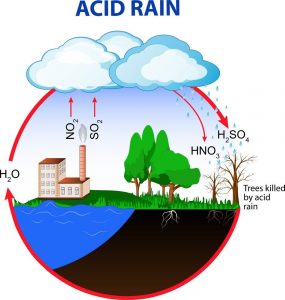 Acid Rains is a phenomenon related to the emission of increasing amounts of sulfur oxides (S) and nitrogen oxides (N) into the atmosphere, in the form of sulfur dioxide (SO2) and nitrogen oxide (NO). These are the main pollutants emitted during the combustion process, in particular, nitrogen oxide (NO) is always released as both nitrogen (N) and oxygen (O) are present in the air. As for sulfur dioxide (SO2), on the other hand, only in some cases is it produced because sulfur (S) is not present in the air, so it must be present in the burned material. The negative effects of acid rain cause the weakening of plants, and therefore produce damage to forests, as well as produce a chemical and physical alteration of soils and waters: this phenomenon leads to the acidification of aquifers and the disappearance of aquatic species present in lakes and rivers. In addition, the acidity of rain also leads to the disintegration of some building materials and the development of respiratory diseases. Fortunately, this problem is diminishing because coal use is decreasing.
Acid Rains is a phenomenon related to the emission of increasing amounts of sulfur oxides (S) and nitrogen oxides (N) into the atmosphere, in the form of sulfur dioxide (SO2) and nitrogen oxide (NO). These are the main pollutants emitted during the combustion process, in particular, nitrogen oxide (NO) is always released as both nitrogen (N) and oxygen (O) are present in the air. As for sulfur dioxide (SO2), on the other hand, only in some cases is it produced because sulfur (S) is not present in the air, so it must be present in the burned material. The negative effects of acid rain cause the weakening of plants, and therefore produce damage to forests, as well as produce a chemical and physical alteration of soils and waters: this phenomenon leads to the acidification of aquifers and the disappearance of aquatic species present in lakes and rivers. In addition, the acidity of rain also leads to the disintegration of some building materials and the development of respiratory diseases. Fortunately, this problem is diminishing because coal use is decreasing.
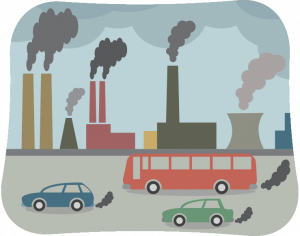 Air Pollution is about changing the normal composition, or physical state, of atmospheric air. This change is due to the presence of one or more substances capable of:
Air Pollution is about changing the normal composition, or physical state, of atmospheric air. This change is due to the presence of one or more substances capable of:
- Altering the normal environmental conditions of health
- Constituting a direct or indirect danger to human health
- Compromising recreational activities or other legitimate uses of the environment
- Altering biological resources, ecosystems, and material goods, both public and private.
The atmospheric pollution can be:
- Natural: dust, volcanic eruptions, fires, decomposition of organic material, and electrical discharges in the atmosphere
- Anthropic: combustion processes, waste disposal, and industrial plants.
Furthermore, these types of pollution can be both local (limited to the area of production of the pollution) and global (the consequences are widespread throughout the planet).
To control air pollution, air quality standards have been established which consider the level of danger of the pollutant in regard to human health. Main pollutants governed by legislation are:
- Particulate matter: any substance, solid or liquid, dispersed in the atmosphere with dimensions of less than a few microns. In urban areas, the difference is made between PM10, i.e. the particulate fraction with dimensions below 10 microns (capable of being retained in the respiratory tract and not reaching the lungs), and PM2.5, i.e. the particulate fraction less than 2.5 microns and is more dangerous than PM10. Some of the negative effects of particulate matter are due to the dirtying of the external surfaces of buildings, the corrosive effect and damage to vegetation, as well as respiratory problems.
- Sulfur oxides: they are caused by anthropogenic action, mainly coming from thermoelectric plants, industrial plants, refineries, and from the production of metals. In addition to causing acid rain, they are also responsible for problems with the respiratory system.
- Nitrogen oxides: they are toxic and irritating to the respiratory tract and are produced by combustion.
- Carbon monoxide: it is a pollutant that is produced by all combustion processes fueled with hydrocarbons and therefore by combustion engines, industrial processes, and natural emissions. It is lethal if the concentration in the body is high, it generally causes loss of concentration, altered reflexes, and migraines.
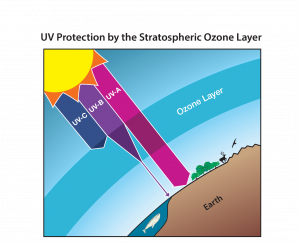 The concept of a hole in the ozone layer is improper and it is more correct to speak of a decrease in the concentration of this gas in the atmosphere. Ozone is the triatomic oxygen (O3) found about 30-40 km above the ground in the stratosphere and reduces the penetration of ultraviolet radiation to the earth. In particular, UVA is able to reach the ground, but UVB and UVC are absorbed by ozone. The main cause of the decrease in atmospheric ozone concentration is the release of chlorofluorocarbons (CFCs), which are found in refrigerants, propellants, insulation materials, and fireproofing materials. Unfortunately, CFCs are also responsible for the greenhouse effect, which is why it’s important to find sustainable materials to replace them. Protection from ultraviolet radiation occurs through a continuous process of production and destruction of molecules. In fact, radiation destroys ozone (O3), producing a diatomic oxygen (O2) and oxygen (O) molecule. Subsequently, the decomposition of CFCs generates chlorine free radicals (CL) that effectively react with ozone, taking away an atom of oxygen. This leads to the limited availability of atomic oxygen needed to complete the cycle and allow ozone regeneration.
The concept of a hole in the ozone layer is improper and it is more correct to speak of a decrease in the concentration of this gas in the atmosphere. Ozone is the triatomic oxygen (O3) found about 30-40 km above the ground in the stratosphere and reduces the penetration of ultraviolet radiation to the earth. In particular, UVA is able to reach the ground, but UVB and UVC are absorbed by ozone. The main cause of the decrease in atmospheric ozone concentration is the release of chlorofluorocarbons (CFCs), which are found in refrigerants, propellants, insulation materials, and fireproofing materials. Unfortunately, CFCs are also responsible for the greenhouse effect, which is why it’s important to find sustainable materials to replace them. Protection from ultraviolet radiation occurs through a continuous process of production and destruction of molecules. In fact, radiation destroys ozone (O3), producing a diatomic oxygen (O2) and oxygen (O) molecule. Subsequently, the decomposition of CFCs generates chlorine free radicals (CL) that effectively react with ozone, taking away an atom of oxygen. This leads to the limited availability of atomic oxygen needed to complete the cycle and allow ozone regeneration.
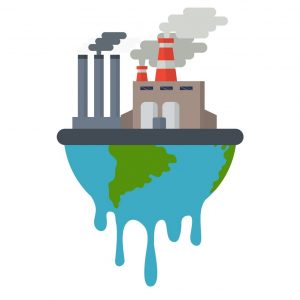 The phenomena of Global Pollution are characterized by the presence of pollution spread throughout the planet and not limited to the geographical area where it was produced. The main phenomena related to global pollution are Acid rain, Decrease in ozone concentration, and the Greenhouse effect.
The phenomena of Global Pollution are characterized by the presence of pollution spread throughout the planet and not limited to the geographical area where it was produced. The main phenomena related to global pollution are Acid rain, Decrease in ozone concentration, and the Greenhouse effect.
 Green Economy (GE) is the economy that use energy and raw materials efficiently, intervene in ecosystems without damaging them, and consider waste as raw materials. It is a theoretical model of economic development that aims to reduce emissions and pollution, increasing energy efficiency and resources. The macro sectors of GE are:
Green Economy (GE) is the economy that use energy and raw materials efficiently, intervene in ecosystems without damaging them, and consider waste as raw materials. It is a theoretical model of economic development that aims to reduce emissions and pollution, increasing energy efficiency and resources. The macro sectors of GE are:
- Renewable energy
- Green buildings
- Sustainable transportation
- Water management
- Waste management
- Land management.
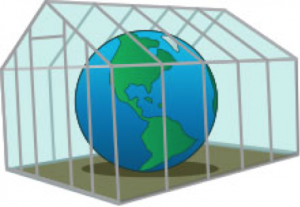 The Greenhouse Effect is a natural phenomenon caused by the presence of gases such as carbon dioxide, water, methane, and nitrogen oxides in the atmosphere. These gases are transparent to incoming solar radiation, however, they are opaque to the radiation emitted by the earth, having a greater wavelength. Without the greenhouse effect, the average temperature of the earth would not be suitable to host living forms, being too low, however, anthropogenic action has increased the greenhouse gases amount in the atmosphere, mainly due to combustion processes and deforestation actions. To quantify the impact of greenhouse gases, emitted by human action, we refer to the Global Warming Potential (GWP).
The Greenhouse Effect is a natural phenomenon caused by the presence of gases such as carbon dioxide, water, methane, and nitrogen oxides in the atmosphere. These gases are transparent to incoming solar radiation, however, they are opaque to the radiation emitted by the earth, having a greater wavelength. Without the greenhouse effect, the average temperature of the earth would not be suitable to host living forms, being too low, however, anthropogenic action has increased the greenhouse gases amount in the atmosphere, mainly due to combustion processes and deforestation actions. To quantify the impact of greenhouse gases, emitted by human action, we refer to the Global Warming Potential (GWP).
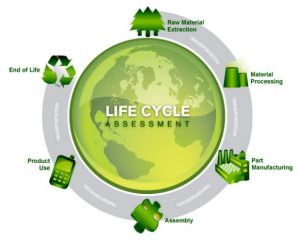 Life Cycle Assessment (LCA) is an analysis methodology that allows evaluating the environmental loads associated with a product, considering the energy used to produce it, the materials consumed, and the final waste. It is used considering three different time frames:
Life Cycle Assessment (LCA) is an analysis methodology that allows evaluating the environmental loads associated with a product, considering the energy used to produce it, the materials consumed, and the final waste. It is used considering three different time frames:
- From cradle to grave, that is from the extraction of the raw materials (necessary during the production process) to the disposal of the product at the end of its life.
- From cradle to gate, that is from the phase of extraction of raw materials to the exit from the plant.
- From cradle to cradle, that is from the extraction of the raw materials (necessary during the production process), up to the recycling of the product at the end of its life.
- From gate to gate, that is from the entrance to the exit of the plant
 Light Pollution increases the brightness of the sky, resulting in decreased visibility of celestial bodies, and it is due to the dispersion of the light flux emitted by lighting systems, in particular:
Light Pollution increases the brightness of the sky, resulting in decreased visibility of celestial bodies, and it is due to the dispersion of the light flux emitted by lighting systems, in particular:
- Inadequate night lighting
- Reflection of the light flux towards the sky
- Incorrect management and maintenance of lighting systems.
This pollution has harmful effects on the environment, altering the vital rhythms of flora and fauna and reducing the possibility of carrying out astronomical research. If light pollution were controlled, energy consumption would also be reduced.
 Noise Pollution causes the introduction of noise into the living and external environment, such as to cause annoyance, disturbance of rest, human activities, danger to human health, and deterioration of ecosystems. Sources of noise pollution include:
Noise Pollution causes the introduction of noise into the living and external environment, such as to cause annoyance, disturbance of rest, human activities, danger to human health, and deterioration of ecosystems. Sources of noise pollution include:
- Noise from inside the building such as conversations, TVs, sound systems, and general appliance noise.
- Noise from outside the building such as noise from construction sites, industrial areas, and vehicles such as cars, trains, and airplanes.
- Impact noise such as falling objects
- Reverberation, i.e., a sound that propagates due to resonance in very large, empty rooms.
To reduce noisy pollution two main actions can be carried out:
- Prevention, adopting good practices to produce little noise
- Protection, mitigating the effects of the noise emitted. Among the various mitigation methods, it is possible to act on the source, along the path that follows the sound or on the receiver.
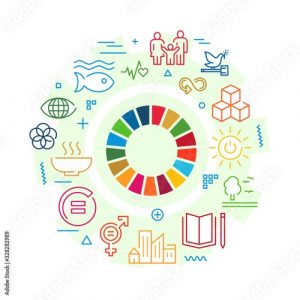 Sustainable development is a concept that emerged in 1987 during the Stockholm conference and states that development should be able to meet the needs of current generations without compromising the ability of future generations to meet their own needs. The concept of sustainable development, therefore, is related to the concept of intergenerational justice. Moreover, sustainability implies social, economic, environmental, and institutional equity.
Sustainable development is a concept that emerged in 1987 during the Stockholm conference and states that development should be able to meet the needs of current generations without compromising the ability of future generations to meet their own needs. The concept of sustainable development, therefore, is related to the concept of intergenerational justice. Moreover, sustainability implies social, economic, environmental, and institutional equity.
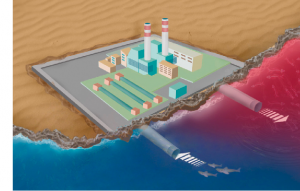 Thermal pollution is linked to the second law of thermodynamics (Carnot’s statement). In fact, using a thermal machine it is not possible to completely transform heat into work but part of the heat supplied to the machine is returned to the external environment.
Thermal pollution is linked to the second law of thermodynamics (Carnot’s statement). In fact, using a thermal machine it is not possible to completely transform heat into work but part of the heat supplied to the machine is returned to the external environment.
The thermal pollution caused by the industries derives mainly from the use of water to cool the thermal machines. In fact, the industries subsequently release the heated water into the environment. One of the worst consequences is linked to the biological alteration, since zooplankton, phytoplankton, fish, and other species have a preferential temperature range within which reproduction and growth are favored. Outside this range, the population decreases until it becomes extinct.
Another form of thermal pollution is related to urban heat islands, i.e. the increase in temperature in urban centers. Usually, the increase is about 4-8 ° C compared to the suburbs and the countryside and is caused by the reduction of vegetation, the waterproofing of the surfaces (which would not allow evapotranspiration), by the urban geometry capable of internally reflecting the radiation infrared and the use of energy sources such as air conditioners, vehicles, and production processes.
Policies and organisation
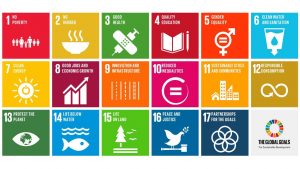 Agenda30 was approved by the UN in 2015 to make the model of development environmentally, economically and socially sustainable. It encompasses 17 Goals in a major program of action with a total of 169 Targets, namely:
Agenda30 was approved by the UN in 2015 to make the model of development environmentally, economically and socially sustainable. It encompasses 17 Goals in a major program of action with a total of 169 Targets, namely:
Goal 1: No poverty
Goal 2: Zero hunger
Goal 3: Good health and well-being
Goal 4: Quality Education
Goal 5: Gender Equality
Goal 6: Clean Water and Sanitation
Goal 7: Clean and Affordable Energy
Goal 8: Decent work and economic growth
Goal 9: Industry, Innovation and Infrastructure
Goal 10: Reduce inequality
Goal 11: Sustainable Cities and Communities
Goal 12: Responsible consumption and production
Goal 13: Climate action
Goal 14: Life Below Water
Goal 15: Life on Land
Goal 16: Peace, Justice and Strong Institutions
Goal 17: Partnership for the Goals
 Agenda21 was signed during the World Conference on Environment and Development in Rio in 1992. It is a document of intentions and programmatic objectives signed by 179 governments and sets out several commitments to be achieved in the 21st century. Agenda 2021 is a supporting element to encourage and monitor sustainable development and is divided into 4 sections and 40 chapters. Section 1 covers the social and economic field, Section 2 covers the conservation and management of resources, Section 3 calls for strengthening the role of social actors, and finally, Section 4 describes the tools for activation. Improving the quality of life, enhancing the potential of the territory, integrating environmental, economic, and social policies, and giving importance to a medium-long term vision have been identified as priority objectives.
Agenda21 was signed during the World Conference on Environment and Development in Rio in 1992. It is a document of intentions and programmatic objectives signed by 179 governments and sets out several commitments to be achieved in the 21st century. Agenda 2021 is a supporting element to encourage and monitor sustainable development and is divided into 4 sections and 40 chapters. Section 1 covers the social and economic field, Section 2 covers the conservation and management of resources, Section 3 calls for strengthening the role of social actors, and finally, Section 4 describes the tools for activation. Improving the quality of life, enhancing the potential of the territory, integrating environmental, economic, and social policies, and giving importance to a medium-long term vision have been identified as priority objectives.
1972
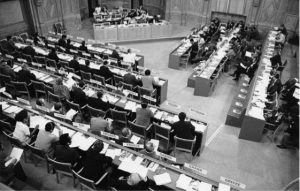 During the Stockholm Conference in 1987, the concept of Sustainable Development was formalized, i.e., a development that ensures the needs of current generations without compromising the ability of future generations to meet their own needs. During this conference, both scientific and political issues were considered and global action was called for.
During the Stockholm Conference in 1987, the concept of Sustainable Development was formalized, i.e., a development that ensures the needs of current generations without compromising the ability of future generations to meet their own needs. During this conference, both scientific and political issues were considered and global action was called for.
1979
 Climate change was recognized as a serious problem by the First World Climate Conference in 1979. This scientific meeting explored how climate change could affect human activities. It issued a declaration calling on the governments of the world “to anticipate and prevent potential human-caused changes in climate that could be detrimental to the well-being of humanity.” Plans to establish a global climate program (WCP) under the joint responsibility of the World Meteorological Organization (WMO), the International Council of Scientific Unions (ICSU), and the United Nations Environment Program (UNEP) were also approved during that conference.
Climate change was recognized as a serious problem by the First World Climate Conference in 1979. This scientific meeting explored how climate change could affect human activities. It issued a declaration calling on the governments of the world “to anticipate and prevent potential human-caused changes in climate that could be detrimental to the well-being of humanity.” Plans to establish a global climate program (WCP) under the joint responsibility of the World Meteorological Organization (WMO), the International Council of Scientific Unions (ICSU), and the United Nations Environment Program (UNEP) were also approved during that conference.
1992
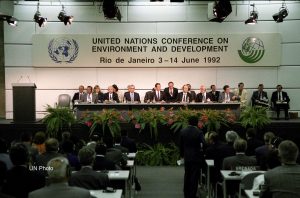 In 1992, in Rio de Janeiro, the United Nations Framework Convention on Climate Change was signed by 154 states plus the European Commission. This conference represents one of the most important milestones in history since key principles on sustainable development were identified and the concepts of “human right” and “right to a healthy environment” were defined. In particular, Agenda21 was signed, a document of intentions and programmatic objectives on environment, economy, and society. It is divided into four sections that are the economic and social dimensions, conservation and management of resources for development, strengthening the role of social forces, and finally, the instruments of implementation. Other agreements adopted in Rio were the Rio Declaration, the Convention on Biological Diversity, and the Forest Principles. The five global acts signed are based on two principles:
In 1992, in Rio de Janeiro, the United Nations Framework Convention on Climate Change was signed by 154 states plus the European Commission. This conference represents one of the most important milestones in history since key principles on sustainable development were identified and the concepts of “human right” and “right to a healthy environment” were defined. In particular, Agenda21 was signed, a document of intentions and programmatic objectives on environment, economy, and society. It is divided into four sections that are the economic and social dimensions, conservation and management of resources for development, strengthening the role of social forces, and finally, the instruments of implementation. Other agreements adopted in Rio were the Rio Declaration, the Convention on Biological Diversity, and the Forest Principles. The five global acts signed are based on two principles:
- Resources and the realization that they must be consumed at a rate that allows nature to restore them.
- Production of goods must avoid the creation of waste, refuse, and pollution that cannot be absorbed by the environment within a reasonable time.
1995
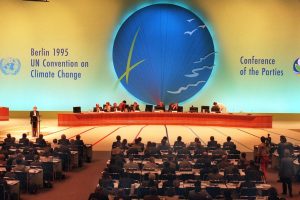 The Conference of the Parties (COP) first met in Berlin in 1995. On this occasion, the countries involved agreed that the commitments made in the Convention for developed countries were inadequate and identified additional commitments.
The Conference of the Parties (COP) first met in Berlin in 1995. On this occasion, the countries involved agreed that the commitments made in the Convention for developed countries were inadequate and identified additional commitments.
1997
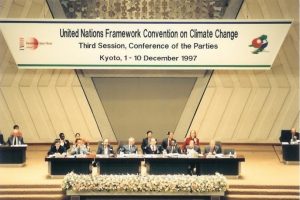 At the third COP meeting (COP-3), organized in Kyoto in 1997, a protocol on the reduction of greenhouse gases was signed by over 160 participants. This protocol took the name of the Kyoto Protocol and regulated greenhouse gases and committed countries to a quantitative reduction of their emissions. In particular, it provided for an emission reduction for States of – 5% (compared to the emission baseline of 1990), to be achieved by 2012. The concept of sustainable development, which emerged during the Stockholm conference, spans four main dimensions of collective life, namely, economic, social, environmental, and institutional sustainability. These concepts highlight the need to generate income and work for the livelihood of the population (economic sustainability), ensuring human well-being, in terms of security, education, health, and sociality (social sustainability). In addition, the conference highlighted the need to maintain the high quality and reproducibility of natural resources (environmental sustainability) and ensure justice, democracy, stability, and participation (institutional sustainability).
At the third COP meeting (COP-3), organized in Kyoto in 1997, a protocol on the reduction of greenhouse gases was signed by over 160 participants. This protocol took the name of the Kyoto Protocol and regulated greenhouse gases and committed countries to a quantitative reduction of their emissions. In particular, it provided for an emission reduction for States of – 5% (compared to the emission baseline of 1990), to be achieved by 2012. The concept of sustainable development, which emerged during the Stockholm conference, spans four main dimensions of collective life, namely, economic, social, environmental, and institutional sustainability. These concepts highlight the need to generate income and work for the livelihood of the population (economic sustainability), ensuring human well-being, in terms of security, education, health, and sociality (social sustainability). In addition, the conference highlighted the need to maintain the high quality and reproducibility of natural resources (environmental sustainability) and ensure justice, democracy, stability, and participation (institutional sustainability).
1998
 The 1998 United Nations Climate Change Conference took place in Argentina. The conference included COP-4 and some global objectives were set, to be achieved through “flexibility mechanisms”. These mechanisms concern the strengthening or establishment of national emission reduction policies, emission accounting, and the possibility of trading in emission rights. Finally, with the “Clean Development Mechanism,” industrialized countries can provide assistance to less developed countries in the fight against climate change, receiving benefits.
The 1998 United Nations Climate Change Conference took place in Argentina. The conference included COP-4 and some global objectives were set, to be achieved through “flexibility mechanisms”. These mechanisms concern the strengthening or establishment of national emission reduction policies, emission accounting, and the possibility of trading in emission rights. Finally, with the “Clean Development Mechanism,” industrialized countries can provide assistance to less developed countries in the fight against climate change, receiving benefits.
2009
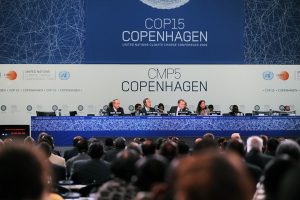 COP-15 took place in Copenhagen with the participation of over 12,000 people. During this conference was discussed and defined the text of the new international climate agreement that replaced, from 2012, the Kyoto Protocol. The text confirms the objective of the EU to limit the increase in global warming to +2 ° C compared to pre-industrial levels.
COP-15 took place in Copenhagen with the participation of over 12,000 people. During this conference was discussed and defined the text of the new international climate agreement that replaced, from 2012, the Kyoto Protocol. The text confirms the objective of the EU to limit the increase in global warming to +2 ° C compared to pre-industrial levels.
2010
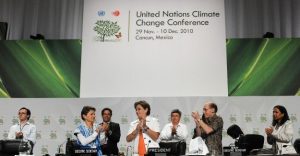 During COP-16, representatives from 193 countries established a global green climate fund to support poor countries and agreed on the need to reduce greenhouse gas emissions by 20% to 40% by 2020.
During COP-16, representatives from 193 countries established a global green climate fund to support poor countries and agreed on the need to reduce greenhouse gas emissions by 20% to 40% by 2020.
2015
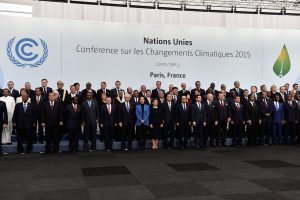 COP-21 took place in Paris in 2015 and highlighted climate change as an urgent and potentially irreversible threat. In particular, it was defined that the temperature could increase up to +2°C compared to the pre-industrial period and that the previously identified targets would be revised every 5 years. An important step concerns the involvement of the whole world, including the most polluting countries.
COP-21 took place in Paris in 2015 and highlighted climate change as an urgent and potentially irreversible threat. In particular, it was defined that the temperature could increase up to +2°C compared to the pre-industrial period and that the previously identified targets would be revised every 5 years. An important step concerns the involvement of the whole world, including the most polluting countries.
2018
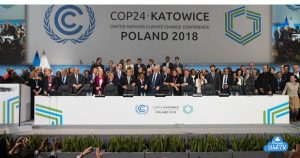 COP-24 took place in Poland in 2018, defining the rules for implementing the 2015 Paris Agreement. In fact, the nearly 200 countries that had signed the agreement defined what was established in France three years earlier as in practice. The general objective was to combat climate change at a global level and define a “Rule Book”, ie a guidebook for implementing all the principles of the Agreement. Since the limit of +2 ° C imposed by COP-21 was considered insufficient, the limit value was lowered to 1.5 ° C, also defining the need for a 45% decrease in CO2 emissions into the air by 2030, a percentage that must rise to 100% by 2050. During the COP-24 it was also established how to distribute the financial resources necessary to support the least developed countries to induce them to reduce their CO2 emissions.
COP-24 took place in Poland in 2018, defining the rules for implementing the 2015 Paris Agreement. In fact, the nearly 200 countries that had signed the agreement defined what was established in France three years earlier as in practice. The general objective was to combat climate change at a global level and define a “Rule Book”, ie a guidebook for implementing all the principles of the Agreement. Since the limit of +2 ° C imposed by COP-21 was considered insufficient, the limit value was lowered to 1.5 ° C, also defining the need for a 45% decrease in CO2 emissions into the air by 2030, a percentage that must rise to 100% by 2050. During the COP-24 it was also established how to distribute the financial resources necessary to support the least developed countries to induce them to reduce their CO2 emissions.
2021
 World leaders gathered in Glasgow in 2021 for COP-26. During the conference, 4 main goals were highlighted:
World leaders gathered in Glasgow in 2021 for COP-26. During the conference, 4 main goals were highlighted:
- Mitigation
- Adaptation
- Climate finance
- Operationalizing the Paris Agreement.
In particular, the need was identified to zero net emissions by 2050 and contain the rise in temperatures by no more than 1.5°C, accelerating the elimination of coal, reducing deforestation and increasing the use of renewable energy. Another key element that emerged relates to supporting the most vulnerable countries to mitigate the impacts of climate change and protect communities and natural habitats, including through the mobilization of funding. Finally, the Paris Agreement and its operationalization was another key element, achievable through transparency in the reporting of GHG emissions and the monitoring of countries’ targets, as well as through the redefinition of carbon market mechanisms.
Sustainability indicators
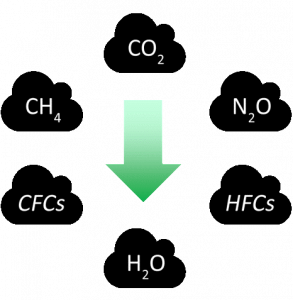 Carbon Dioxide Equivalent is a measure that expresses the impact on global warming of a certain quantity of greenhouse gases compared to the same quantity of carbon dioxide (CO2). The equivalent tons are calculated by making the product of the tons of gas produced and its GWP, that is, a value that indicates the dangerousness of the gas with respect to the mass unit of CO2. The reason we refer to CO2 is that it is the most abundant gas even if it is not the most dangerous.
Carbon Dioxide Equivalent is a measure that expresses the impact on global warming of a certain quantity of greenhouse gases compared to the same quantity of carbon dioxide (CO2). The equivalent tons are calculated by making the product of the tons of gas produced and its GWP, that is, a value that indicates the dangerousness of the gas with respect to the mass unit of CO2. The reason we refer to CO2 is that it is the most abundant gas even if it is not the most dangerous.
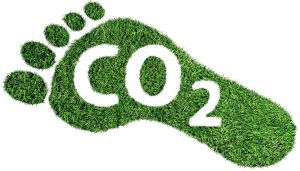 Carbon Footprint expresses the total amount of CO2 and other greenhouse gases associated with an activity or a product. It is an environmental indicator that measures the impact of human activities on the climate. In the calculation, therefore, all gases are taken into account ,in reference to their Global Warming Potential (GWP).
Carbon Footprint expresses the total amount of CO2 and other greenhouse gases associated with an activity or a product. It is an environmental indicator that measures the impact of human activities on the climate. In the calculation, therefore, all gases are taken into account ,in reference to their Global Warming Potential (GWP).
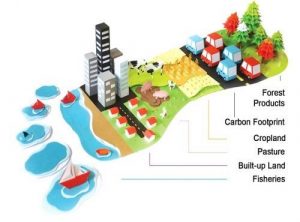 Ecological Footprint is the amount of land and sea necessary to support the needs of a reference population. It includes the surface necessary to regenerate the resources consumed and the surface necessary for the disposal of the waste produced as well as the anthropogenic occupation of the territory. If we compare the ecological footprint with biocapacity, that is the availability of production area, it is possible to evaluate the sustainability of the consumption levels of the reference population. For clarity, if the ecological footprint is greater than the surface the population has (biocapacity) then the population is using too many resources.
Ecological Footprint is the amount of land and sea necessary to support the needs of a reference population. It includes the surface necessary to regenerate the resources consumed and the surface necessary for the disposal of the waste produced as well as the anthropogenic occupation of the territory. If we compare the ecological footprint with biocapacity, that is the availability of production area, it is possible to evaluate the sustainability of the consumption levels of the reference population. For clarity, if the ecological footprint is greater than the surface the population has (biocapacity) then the population is using too many resources.
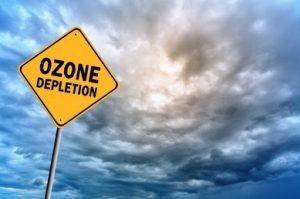 Ozone Depletion Potencial is a useful indicator to express the danger of a molecule with respect to ozone. In fact, ozone protects living things and plants from UV radiations and is important for life on earth. The anthropic action has led to a substantial decrease in the concentration of stratospheric ozone and it is necessary to intervene as soon as possible.
Ozone Depletion Potencial is a useful indicator to express the danger of a molecule with respect to ozone. In fact, ozone protects living things and plants from UV radiations and is important for life on earth. The anthropic action has led to a substantial decrease in the concentration of stratospheric ozone and it is necessary to intervene as soon as possible.
 Water Footprint is an indicator that makes it possible to calculate the total water consumption required to carry out an activity or create a product. It takes into account both direct and indirect uses, specifically:
Water Footprint is an indicator that makes it possible to calculate the total water consumption required to carry out an activity or create a product. It takes into account both direct and indirect uses, specifically:
- Blue water: surface or groundwater used and not returned to the water system, such as water used for irrigation.
- Green water: rainwater used during the production process, which does not replenish surface or groundwater resources.
- Grey water: water used to dilute pollutants and replenish surface and groundwater resources.
The average Water Footprint values of some products are listed below:
WF (bottle of wine) = 438 l (90% cultivation and 10% production)
WF (bottle of oil) = 5485 l (99% cultivation and 1% production)
WF (1kg of pork) = 6500 l (99% feed production and 1% livestock and other activities)



